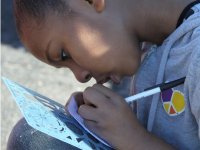Giving Students Charge of How They Learn
By letting students determine how they learn, via task design, rubric development, and student-led parent conferences, we see high engagement, in-depth inquiry, and quality work.
A parent asked me for advice about an assignment that her son did not want to do. He had to research the architectural style of Frank Lloyd Wright and create a presentation that included a diorama. He wasn't interested in doing any of the work. She could make him comply, but the quality of his research and everything that followed would be in jeopardy.
"Does he play Minecraft?" I asked.
"Yes," the mom said.
"Why doesn't he create the 3D model in Minecraft?"
Her son was ecstatic. He dove into the research, created the 3D model, and rocked the presentation with enthusiasm.
Teachers must embrace their students' capacity to learn through leading when given the chance -- as the previous posts in this series have suggested. Letting students take charge of how they learn leads to high engagement, in-depth inquiry, and quality work.
Student-Developed Products Based on Learning Targets
We invest the most in tasks that we get to choose. What if the learning outcome is evaluating counterarguments and creating one for a community purpose? Students could develop a 10- to 20-minute documentary, podcast commentary, or staged debate on a social media platform. Each task requires research analysis of different viewpoints by authors and social media commentators. Students develop a well-reasoned script that goes through several revisions before the final production.
There are many apps and tools that students can use to demonstrate understanding of concepts in any subject. How?
Ask the students. Give them the outcome result and charge them with the challenge to use any available tools via high and low tech.
Start small. Give students three choices. The first two choices are teacher-structured with the requirements and methods laid out. Include one or two wildcard elements that students have a voice in shaping. As the third choice, offer a blank check, challenging students to design the task. Give them the learning targets that they must demonstrate. They propose a plan, and you determine if it's acceptable.
Student-Developed Rubrics
Rubrics are a valuable tool for formative assessment. First and foremost, rubrics provide information to students and teachers about how learning is progressing. It's an ongoing coaching tool for self-assessment, peer coaching, and teacher support of the quality of work and the areas for growth.
Students need to understand the rubric for its formative assessment power to be realized, and there lies the challenge. At best, understanding a teacher-created rubric requires repeated review over time before "most" students understand it at a proficient level. It's the same as when a teacher teaches a unit for the first time using lesson plans written by another teacher -- it's possible, and the person will improve over time. Yet with rubrics, how much time do teachers and students have?
Teachers can save time by including students in designing the rubric. When students craft the descriptors, they develop a common understanding of what quality learning looks like. The best part is that, typically, students establish rigorous expectations that they would not buy into if the teacher gave them the same document. It may take a class 20-40 minutes to co-develop high-quality expectations that the students design, understand, and agree to complete. That's time well spent.
Student-Led Conferences
Over several years, when my children conducted student-led conferences, I learned more about their academic growth than at any parent-teacher conference. It helped that the teacher didn't sit in on the conversation so that the students could lead.
Parent-teacher conferences are about the adults discussing the student's progress without her being part of the conversation. The student might be present, but she only gets to respond to topics set by the adults. The result is that the adults are doing the heavy lifting while the student daydreams about what she'll be doing when the meeting is over.
Student-led conferences are excellent opportunities for students to explore and reflect on their learning journey. When they facilitate the conversation with parents or guardians, the rich benefits are in the students' preparations prior to the meeting. They review products that show their growth during the marking period. They analyze how the work connects with their grades or standards-based competencies and evaluate next steps for continued growth.
Here are some resources to explore this amazing approach:
Set Students Free to Learn With You
As a parent of two children, I've experienced different instructional approaches, from progressive public K-8 programs such as Montessori to a project-based learning high school. My teens had experiences where they were encouraged to construct their learning and establish academic criteria -- for example, Innovation Days at their high school.
The students spent two days designing and developing ideas that fueled their passions. One group of students played percussion instruments for hours, experimenting with beats and sounds. Only one of them used a standard drum kit. The rest played with drumsticks on a variety of surfaces. In a science room, students built motorized vehicles, while a student in another room attempted to explain the abstract science concepts behind the chapter that she was writing. Teachers coached or provided the muscle that students requested to attain their vision.
On the second day, after some revision time, students presented their works to the school community. My daughter spent hours on her presentation, forgoing her usual free-time passions. Based on interviewing the students, I recognized significant practice of ELA standards, including the writing process (Wri. 5), organization of ideas (Wri. 4), and speaking and listening.
When teachers trust students to lead their learning by giving more open-ended opportunities that challenge them to find their way, students will delve deeper into content and set their expectations higher than is required.
